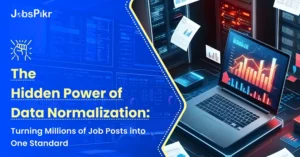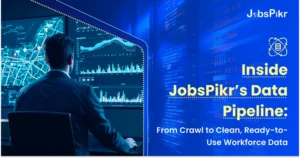Hiring has always been complex. Anyone who’s worked in recruitment knows the pain of sorting through stacks of resumes, juggling interview calendars, and making decisions based on gut feelings. Today, the landscape has changed dramatically thanks to HR automation.
The rise of remote work, increasing job fluidity among younger generations, and explosive industry trends—from AI to sustainability—mean companies can’t afford outdated hiring practices.
Let’s explore how modern companies are using technology to streamline hiring, plan for workforce needs, and retain their talent.
Why Traditional Hiring Falls Short in Respect to HR Automation

Image Source: Vervoe
The Inefficiencies We’ve Accepted for Too Long
Even today, many hiring processes remain surprisingly manual. A hiring manager once joked that their team’s big innovation was moving from red pens to highlighters when reviewing resumes. While that’s amusing, it reflects a deeper issue: too much time is wasted on tasks that technology could handle more efficiently—and more fairly.
Consider these typical bottlenecks:
- Resume overload: A midsize company may receive 250+ applications for a single role. Even if a recruiter spends just two minutes per resume, that’s over eight hours of work for one position—and it doesn’t account for follow-ups, screening calls, or interviews.
- Unconscious bias: Despite best intentions, bias is baked into human decision-making. A Yale study found that 72% of hiring managers believe they’re objective, yet identical resumes with traditionally “white-sounding” names receive 50% more callbacks than those with names perceived as ethnic.
- Firefighting vs. planning: Most companies only recruit reactively, when someone quits or a team is overwhelmed. This leads to rushed hiring, mismatched roles, and poor onboarding experiences.
How HR Automation Can Help
Modern hiring tools like JobsPikr do more than save time; they add consistency and intelligence to the process.
- Candidate-facing chatbots: Tools like Paradox and Mya answer common questions, schedule interviews, and nudge candidates throughout the process. UPS reduced its time-to-interview from days to minutes by integrating these solutions.
- Smart applicant tracking systems (ATS): Platforms like Lever and Greenhouse are evolving beyond keyword matching. They analyze patterns like portfolio clients, project success rates, or tenure length to flag high-potential candidates, even if they don’t tick every box.
- Asynchronous skill testing: Companies like Codility allow candidates to demonstrate coding or problem-solving skills at their own pace, in their own environment. This reduces stress and often yields more authentic performance than high-pressure live interviews.
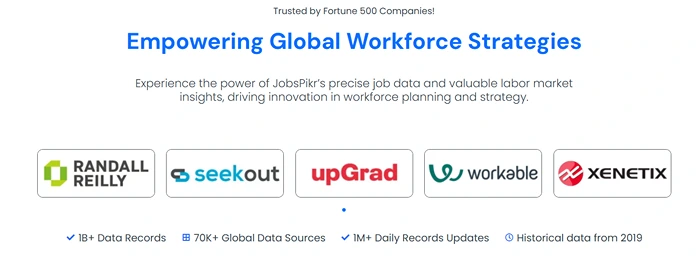
Tools like JobsPikr help businesses understand the talent market, the skills in demand, and the concentration of candidate pools per geography. This data can be extremely useful for businesses looking to hire or expand to different markets and need a reliable pool of candidates.
Forecasting the Future: Predictive Hiring at Work
Using Data to Plan Instead of React
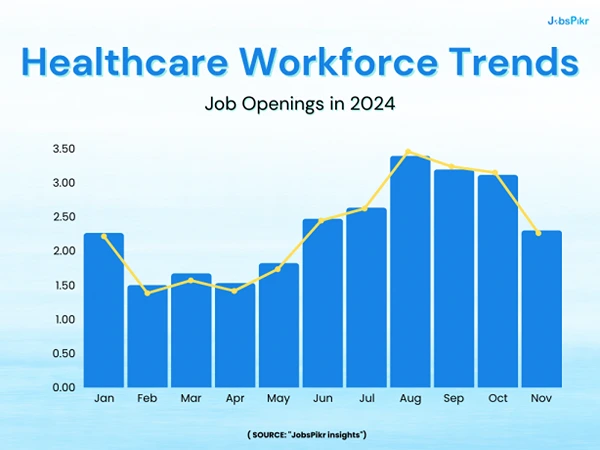
JobsPikr Healthcare Workforce Trends
In 2019, Walmart used an innovative approach to predict labor needs across its U.S. stores. By analyzing weather forecasts, local economic indicators, and historical shopping patterns, they accurately projected how many staff would be needed in each role, months in advance. When COVID-19 disrupted global supply chains, Walmart had a talent cushion. Many competitors did not.
This is the power of workforce forecasting: using data not just to understand what’s happening now, but to anticipate what’s next.
A. Getting Ahead of Turnover
Organizations like Salesforce are deploying predictive models to flag employees at risk of leaving. These models consider:
- Survey data on engagement and burnout
- Frequency of LinkedIn profile updates
- Managerial support patterns (e.g., teams with weekly 1:1s see 32% lower attrition)
By identifying at-risk employees early, HR teams can intervene, offering support, coaching, or growth opportunities before the resignation letter arrives.
B. Mapping Emerging Skill Gaps
Companies are also using forecasting to identify the future skills they’ll need, before they become urgent.

For instance, Adobe’s internal analysis in 2022 revealed that 60% of marketing roles would soon require competency in AI prompt engineering. Rather than scramble for talent, they partnered with Coursera to create upskilling pathways, helping employees develop the needed skills internally.
Understanding skill gaps not only builds loyalty but saves on hiring costs in the long run.
C. Scenario Planning for Strategic Resilience
What if inflation forces a hiring freeze? What if your new product line goes viral? What if a key team decides to unionize?
Tools like Eightfold.ai allow HR leaders to simulate 20+ future scenarios—staffing, budgeting, even DEI impact—so they can make informed decisions faster. One tech CEO described it as “playing Civilization with your company,” but the outcomes affect real lives and livelihoods.
Human + Machine: Striking the Right Balance
Tech That Supports, Not Replaces
It’s easy to get carried away with shiny new tools, but poorly implemented automation can alienate top talent. Ever submit a job application and never hear back? That’s bad automation.
The goal isn’t a robot-led hiring process, it’s to have a hybrid approach.
Case Study: Unilever’s Smart Hiring Process
- Candidates begin with neuroscience-based games that assess memory, empathy, and decision-making.
- AI evaluates recorded video interviews for clarity, energy, and key communication signals.
- Human recruiters step in only for candidates who pass these filters, focusing their time where it matters most.
The results? A 16% increase in hire diversity, and a 75% faster process overall. One candidate even remarked, “It felt like the system actually wanted to understand me, not just my resume.”
Avoiding the HR Automation Pitfalls
Of course, automation isn’t foolproof. In 2018, Amazon scrapped a hiring algorithm that penalized resumes containing the word “women’s” (as in “women’s chess club captain”). The algorithm had learned this bias from historical hiring data, which favored male candidates.
The solution wasn’t to ditch AI altogether—it was to introduce transparency and regular auditing. Today, leading companies treat AI like a colleague: useful, but in need of oversight and ethical guardrails.
Making Smart Hiring Accessible to All
Tools for Smaller Teams
You don’t need an enterprise budget to modernize your hiring process.
- Affordable automation: Tools like BambooHR offer onboarding, e-signatures, and employee surveys for as little as $6 per employee per month.
- DIY forecasting: Google Sheets can be a surprisingly powerful forecasting tool. By tracking turnover rates and average time-to-hire, even small HR teams can plan ahead.
- Flexible interviews: Platforms like HireVue allow you to record structured interview questions once, letting candidates respond when it works for them. This eliminates scheduling headaches and levels the playing field for working parents or candidates in other time zones.
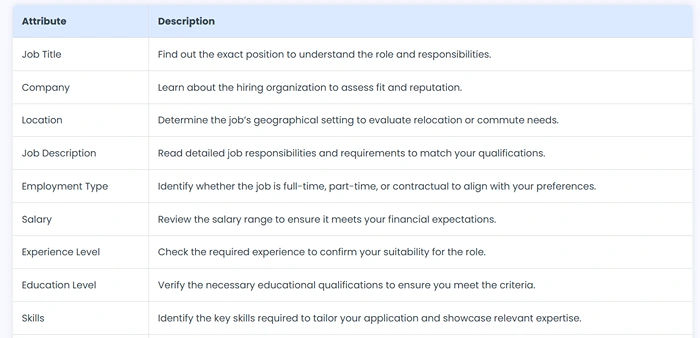
And JobsPikr provides access to all types of candidate job data from across the world.
Even small businesses are seeing the impact. A bakery owner in Austin shared, “I used to hire based on who could work weekends. Now I use seasonal sales data to plan three months ahead. It changed everything.”
Where Human Insight Still Matters Most
The Irreplaceable Human Factor
Despite the gains in efficiency and consistency, some decisions simply require human nuance.
Here’s what HR leaders say they’ll never automate:
- Cultural alignment: Algorithms can’t yet assess whether a candidate will challenge the status quo in a constructive way, or bring new energy to a team dynamic.
- Leadership potential: Should a high-performing individual contributor become a manager? That requires emotional intelligence, not just a performance score.
- Moments of crisis: During layoffs or team conflict, people need empathy, not efficiency. No algorithm can deliver compassion.
As one CHRO put it, “Tech tells me who we can hire. But why do they stay? That’s still our job.”
The Bottom Line: Hiring for the Future
Smarter hiring isn’t about replacing recruiters with robots—it’s about augmenting their capabilities. Automation handles the repetitive tasks. Forecasting provides clarity. Together, they allow human decision-makers to focus on building teams that thrive.
The companies that win in today’s talent market don’t just screen faster, they build better relationships. They use AI to reduce bias but still schedule real conversations. They plan for the future but stay grounded in values.
Because ultimately, people don’t quit jobs—they quit cultures. And no algorithm can build a culture. At least, not yet.

